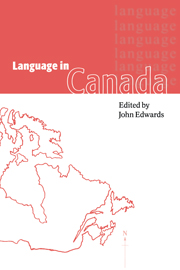Book contents
- Frontmatter
- Contents
- List of figures
- List of maps
- List of tables
- Notes on contributors
- 1 Canada
- Introduction
- 1 The foundations
- 2 The fading Canadian duality
- 3 Official bilingualism: from the 1960s to the 1990s
- 4 Official multiculturalism
- 5 Language in education: bridging educational policy and social psychological research
- 6 Aboriginal languages: history
- 7 Aboriginal languages: current status
- 8 French: Canadian varieties
- 9 French in Quebec
- 10 French in New Brunswick
- 11 French outside New Brunswick and Quebec
- 12 English: Canadian varieties
- 13 English Quebec
- 14 The teaching of international languages
- 15 French immersion in Canada
- 16 Language in Newfoundland
- 17 Language in Prince Edward Island
- 18 Language in Nova Scotia
- 19 Language in New Brunswick
- 20 Language in Quebec: aboriginal and heritage varieties
- 21 Language in Ontario
- 22 Language in Manitoba
- 23 Language in Saskatchewan: Anglo-hegemony maintained
- 24 Language in Alberta: unilingualism in practice
- 25 Language in British Columbia
- 26 Language in the Northwest Territories and the Yukon Territory
- Index of names
- Index of language families, languages, dialects
- Index of subjects
20 - Language in Quebec: aboriginal and heritage varieties
Published online by Cambridge University Press: 18 February 2010
- Frontmatter
- Contents
- List of figures
- List of maps
- List of tables
- Notes on contributors
- 1 Canada
- Introduction
- 1 The foundations
- 2 The fading Canadian duality
- 3 Official bilingualism: from the 1960s to the 1990s
- 4 Official multiculturalism
- 5 Language in education: bridging educational policy and social psychological research
- 6 Aboriginal languages: history
- 7 Aboriginal languages: current status
- 8 French: Canadian varieties
- 9 French in Quebec
- 10 French in New Brunswick
- 11 French outside New Brunswick and Quebec
- 12 English: Canadian varieties
- 13 English Quebec
- 14 The teaching of international languages
- 15 French immersion in Canada
- 16 Language in Newfoundland
- 17 Language in Prince Edward Island
- 18 Language in Nova Scotia
- 19 Language in New Brunswick
- 20 Language in Quebec: aboriginal and heritage varieties
- 21 Language in Ontario
- 22 Language in Manitoba
- 23 Language in Saskatchewan: Anglo-hegemony maintained
- 24 Language in Alberta: unilingualism in practice
- 25 Language in British Columbia
- 26 Language in the Northwest Territories and the Yukon Territory
- Index of names
- Index of language families, languages, dialects
- Index of subjects
Summary
Although Quebec is the only officially unilingual francophone province in Canada – with a francophone majority and an anglophone minority – there are, as in the other provinces, language communities whose members speak neither French nor English as their mother tongue. As elsewhere in Canada, an important distinction is made between aboriginal and allophone (persons not of French-, English- or aboriginal-language origin) communities.
The First Nations, descendants of communities established in North America about 10,000 years before the arrival of Europeans in the sixteenth century, include Amerindian and Inuit societies. The allophone communities arrived after the French and English ones were well established, from the nineteenth century onwards, and were traditionally from European origins other than French or Anglo-Celtic. Since the 1960s, non-European allophone communities have been growing rapidly. Compared to the rest of Canada, the percentage of speakers of a language other than French or English is relatively small in Quebec (6.8 per cent versus 14.9 per cent). In 1986, there were approximately 650,000 allophone Quebecers of neither French nor English origin, 73,590 Amerindians and 7,355 Inuit.
As a predominantly French-speaking entity, Quebec constitutes a distinct society in English-speaking North America. Language planning by successive provincial governments has transformed the society from an English-dominant to a French-dominant one.
- Type
- Chapter
- Information
- Language in Canada , pp. 384 - 398Publisher: Cambridge University PressPrint publication year: 1998



